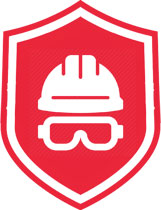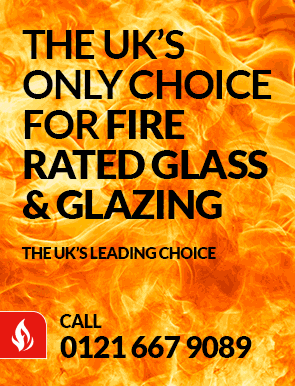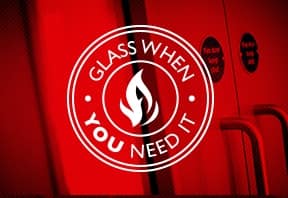
WHAT IS SAFETY GLASS?
Safety glass is glass that has some form of safety function from an Impact Safety Rating point of view. It is harder to break than ordinary glass and does not shatter in the same way due to either the specific processing the glass has gone through (toughened) or the bonded interlayer between the glass itself (laminated).
It is used to protect against injury on impact with the glass and is suitable for locations with a high risk of accidental damage or where there is an increased risk of vandalism. It must also be used in certain Critical Locations as per Building Regulations requirements.
TECHNICAL INFORMATION: SAFETY GLASS
Click on the tabs below to view technical details on Safety Glass.
In accordance with BS EN 12600:2002, impact testing is carried out on glass samples measuring 876mm x 1938mm where an impactor weighing 50Kg is released from a pendulum mechanism at 3 different drop heights
The performance classification is given as α (β) φ
Where
190mm drop height (3B3) is considered to be equivalent to an adult pushing hard against the glass or a child running into it.
450mm drop height (2B2) is considered to be equivalent to more than an adult walking into a glass door but less than a determined attempt to force a way through by running at it.
1200mm drop height (1B1) is considered to be equivalent to a full-grown adult running into the glass with insignificant or no injury.
PLEASE NOTE:
Materials meeting the performance criteria of BSEN 12 600 and are classified as safety material MUST carry a mark indicating the level of safety achieved during test. The table below provides a comparison between classifications (in order of highest performance) within BS EN 12600 and BS6206:
| BS EN 12600 | BS 6206 |
| 1B1 | Class A |
| 2B2 | Class B |
| 3B3 | Class C |
To identify the grade of safety glass used each pane should be indelibly marked so that the marking is visible after installation.
For more information see: www.gov.uk/government/publications/protection-from-falling-collision-and-impact-approved-document-k.
TYPICAL SAFETY GLASS USAGE
Due to laminated glass remaining intact on impact it is generally used where there is a risk of an incident caused by falling glass should the glass be damaged, as well as where there is high human impact and the need to prevent potential injury. Laminated glass is frequently used in exterior shop-fronts, curtain walling and windows, overhead glazing, full-height barriers, doors and low-level glazing. It has many commercial, public and residential applications.Toughened glass also has a number of applications and in building projects it is often used as glass facades, Glass Partitions,, sliding doors, glass doors and windows. It is also used in furniture such as table and counter tops.
We have our own Toughening Plant and can provide toughened glass cut to size ranging from 4mm to 25mm in thickness.
As with other types of glass, safety glass is flexible and can be used in different forms; including within IGUs and with colour/tinted options.
Safety glass is not of itself fire resistant but there are certain types of fire rated glass that come with safety impact ratings. In particular, our 19mm FireSafe Modified Toughened product which is certified fire resistant and physical attack resistant and has been specially developed for use in secure institutions as vision panels, side screens and partition walling. Our Glass Selector tool will help you identify products that are both fire-rated and impact safety rated.
FEATURES OF SAFETY GLASS:
- In house Toughening Plant
- Standard and acoustic laminated glass
- Coloured and tinted options available
- Nationwide delivery
- Trade counter collection at all Branches
- Attestation Level 1
| LAMINATE TYPE | FIRE RATING | ACOUSTIC RATING dB (RW) | SAFETY RATING |
|---|---|---|---|
| 6.4mm CLEAR LAMINATED GLASS | NFR | 32 | 2B2 |
| 7.5mm CLEAR LAMINATED GLASS | NFR | 32 | IBI |
| 8.8mm CLEAR LAMINATED GLASS | NFR | 33 | IBI |
| 9.5mm CLEAR LAMINATED GLASS | NFR | 33 | IBI |
| 10.8mm CLEAR LAMINATED GLASS | NFR | 33 | IBI |
| 11.5mm CLEAR LAMINATED GLASS | NFR | 34 | IBI |
| 6.8mm CLEAR ACOUSTIC LAMINATED GLASS | NFR | 35 | IBI |
| 8.8mm CLEAR ACOUSTIC LAMINATED GLASS | NFR | 37 | IBI |
| 10.8mm CLEAR ACOUSTIC LAMINATED GLASS | NFR | 38 | IBI |
| 12.8mm CLEAR ACOUSTIC LAMINATED GLASS | NFR | 39 | IBI |
| 16.8mm CLEAR ACOUSTIC LAMINATED GLASS | NFR | 40 | IBI |
THE BENEFITS OF SAFETY GLASS
There are different types of safety glass, each with its own benefits depending the intended usage and impact safety rating required.Laminated Glass – this safety and security glass is typically made up of one or more panes of glass with bonded interlayers of PVB (polyvinyl butyral). This type of glass is no stronger than ordinary glass but it will remain intact on impact as a result of the bonded interlayer which prevents the glass from breaking into large pieces. It can therefore withstand repeated blows from heavy objects and remain as a barrier to entry even if the glass has been broken. Laminated glass can have different impact ratings depending on the thickness of the glass used and the number of interlayers. It can also provide sound insulation (acoustic abilities) and thermal insulation (energy efficiency).
Toughened Glass – this safety and security glass is processed by a controlled thermal or chemical treatment to significantly increase its strength compared to ordinary non-processed glass. Whilst significantly stronger (up to five times) this type of glass is still breakable on impact. However, it will not break in the same way as ordinary glass – it does not break into large jagged shards and will instead break into small cube-liked pieces that are less likely to cause injury. The key benefit of toughened glass is its strength in terms of the impact required to break it – it has the highest performing classification of impact rating.
Wired Glass – this is a type of safety and security glass due to the wire netting embedded within it during the manufacturing process. The wire netting reduces the probability of the glass shattering on impact and is intended to hold the glass together if it cracks. However, this type of glass still breaks in the same way as ordinary glass and it will break into large jagged pieces on impact outside of its impact safety rating.
Building Regulations set out specific requirements with regards to protection from impact with glazing and these include what impact safety rating must be used in Critical Locations.
Ordinary annealed glass may be used in small panes up to a maximum width of 250mm and an area not exceeding 0.5m2. Such glass must not be less than 6mm in thickness, except in the case of traditional leaded lights and copper lights, where 4mm can be used.

1. GLAZING IN DOORS
Any glass within 1500mm from floor level including any glass in doors that does not start over 1500mm from the floor must be safety glass.
2. GLAZING ADJACENT TO DOORS
Any windows or glass panels within 300mm of the edge of a door and which is also wholly or partially within 1500mm from floor level must be safety glass.
3. LOW LEVEL GLAZING
Any other kind of glazing that is within 800mm from floor level. This means that windows that are not located within 300mm of a door must use safety glass if the bottom of the glazing is within 800mm of the floor level.
Click here to download a pdf of Where to install saferty Glass (Critical Location)


TESTING
As part of the testing process, a weight is dropped from three heights onto a standard sized pane of safety glass. The glass is then given an impact safety rating based on the point at which it breaks (if it breaks).
